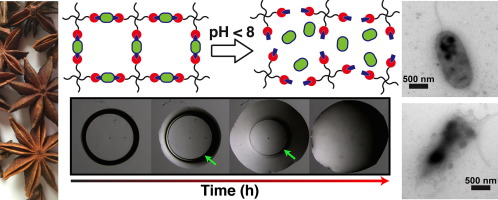Acta Biomaterialia ( IF 9.7 ) Pub Date : 2017-12-18 , DOI: 10.1016/j.actbio.2017.12.016 Douglas V Amato 1 , Dahlia N Amato 1 , Logan T Blancett 2 , Olga V Mavrodi 2 , William B Martin 1 , Sarah N Swilley 1 , Michael J Sandoz 1 , Glenmore Shearer 2 , Dmitri V Mavrodi 2 , Derek L Patton 1

|
The synthesis of a fully degradable, bio-based, sustained release, pro-antimicrobial polymer network comprised of degradable acetals (PANDA) is reported. The active antimicrobial agent – p-anisaldehyde (pA) (an extract from star anise) – was converted into a UV curable acetal containing pro-antimicrobial monomer and subsequently photopolymerized into a homogenous thiol-ene network. Under neutral to acidic conditions (pH < 8), the PANDAs undergo surface erosion and exhibit sustained release of pA over 38 days. The release of pA from PANDAs was shown to be effective against both bacterial and fungal pathogens. From a combination of confocal microscopy and transmission electron microscopy, we observed that the released pA disrupts the cell membrane. Additionally, we demonstrated that PANDAs have minimal cytotoxicity towards both epithelial cells and macrophages. Although a model platform, these results point to promising pathways for the design of fully degradable sustained-release antimicrobial systems with potential applications in agriculture, pharmaceuticals, cosmetics, household/personal care, and food industries.
Statement of significance
With the increasing number of patients prescribed immunosuppressants coupled with the rise in antibiotic resistance – life-threatening microbial infections are a looming global threat. With limited success within the antibiotic pipeline, nature-based essential oils (EOs) are being investigated for their multimodal effectiveness against microbes. Despite the promising potential of EOs, difficulties in their encapsulation, limited water solubility, and high volatility limit their use. Various studies have shown that covalent attachment of these EO derivatives to polymers can mitigate these limitations. The current study presents the synthesis of a fully-degradable, sustained release, cytocompatible, pro-antimicrobial acetal network derived from p-anisaldehyde. This polymer network design provides a pathway toward application-specific EO releasing materials with quantitative encapsulation efficiencies, sustained release, and broad-spectrum antimicrobial activity.
中文翻译:

通过可降解的乙缩醛键连接的生物基抗微生物聚合物网络。
据报道,由可降解的乙缩醛(PANDA)组成的完全可降解的,基于生物的,持续释放的抗微生物聚合物网络已经合成。活性抗微生物剂-对茴香醛(pA)(八角茴香的提取物)被转化为含有抗微生物单体的可紫外线固化的乙缩醛,然后光聚合为均质的硫醇-烯网络。在中性至酸性条件下(pH <8),PANDA会遭受表面侵蚀,并在38天之内呈现出持续释放的pA。从PANDAs中释放出pA可有效抵抗细菌和真菌病原体。从共聚焦显微镜和透射电子显微镜的组合,我们观察到释放的pA破坏了细胞膜。此外,我们证明了PANDA对上皮细胞和巨噬细胞具有最小的细胞毒性。尽管是一个模型平台,但这些结果为设计可完全降解的缓释抗菌系统提供了有希望的途径,并有望在农业,制药,化妆品,家庭/个人护理和食品行业中应用。
重要声明
随着开处方的免疫抑制剂的患者人数的增加以及抗生素耐药性的增加,威胁生命的微生物感染已成为一种迫在眉睫的全球性威胁。由于在抗生素管道中取得的成功有限,人们正在研究基于自然的精油(EOs)对微生物的多峰有效性。尽管EO具有潜在的前景,但它们的封装困难,水溶性有限和高挥发性限制了它们的使用。各种研究表明,这些EO衍生物与聚合物的共价结合可以减轻这些限制。当前的研究提出了衍生自对茴香醛的可完全降解,持续释放,细胞相容性,抗微生物缩醛前体网络的合成。



























 京公网安备 11010802027423号
京公网安备 11010802027423号